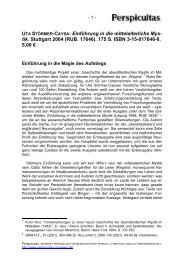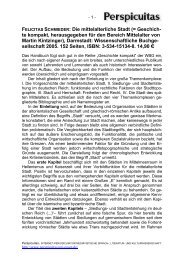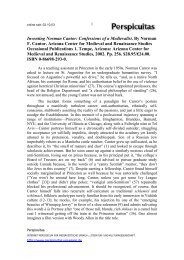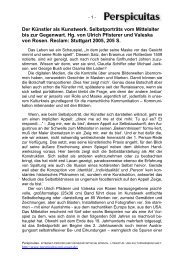Popular Protest in Late Medieval Europe: Italy, France, and Flanders
Popular Protest in Late Medieval Europe: Italy, France, and Flanders
Popular Protest in Late Medieval Europe: Italy, France, and Flanders
Create successful ePaper yourself
Turn your PDF publications into a flip-book with our unique Google optimized e-Paper software.
- 1 -<strong>Popular</strong> <strong>Protest</strong> <strong>in</strong> <strong>Late</strong> <strong>Medieval</strong> <strong>Europe</strong>: <strong>Italy</strong>, <strong>France</strong>, <strong>and</strong>Fl<strong>and</strong>ers (Manchester <strong>Medieval</strong> Sources). Ed. by Samuel K.Cohn, Jr. Manchester: Manchester University Press, 2004.Paper, xxiv + 389 pp. ISBN 0-7190-6731-6. $24.95.Although Cohn did not accomplish his orig<strong>in</strong>al objective of a broad sourcebookcover<strong>in</strong>g late medieval <strong>Europe</strong>, readers still will f<strong>in</strong>d this an outst<strong>and</strong><strong>in</strong>g collection ofsource material, much of it translated <strong>in</strong>to English for the first time. The model for thissourcebook was R.B. Dobson’s The Peasants’ Revolt of 1381 (London, 1983), <strong>and</strong>the editor’s primary aim is to provide substantial background <strong>and</strong> context for the othertwo major revolts of the fourteenth century, the French Jacquerie <strong>and</strong> the Florent<strong>in</strong>eCiompi rebellion. Simultaneously, the selections permit an exploration of the generalatmosphere of protest <strong>and</strong> revolt follow<strong>in</strong>g the Black Death. The material presentedspans 178 years, with documents relat<strong>in</strong>g to the Jacquerie <strong>and</strong> the period from 1378to 1382 naturally fill<strong>in</strong>g two-thirds of the text. The material is arranged partly bychronology, partly thematically. The notes at the beg<strong>in</strong>n<strong>in</strong>g of the chapters <strong>and</strong>sections provide just the right amount of context; the footnotes are <strong>in</strong>formative whilekept to a m<strong>in</strong>imum to focus on the text. Consequently, the collection is easy to use<strong>and</strong> navigate, <strong>and</strong> a reader unfamiliar with these revolts will not be lost or confusedas to the personages <strong>and</strong> ideas encountered.Cohn frequently refers to the ideas laid out by M. Mollat <strong>and</strong> P.Wolff <strong>in</strong> Ongles,bleus, Jacques et Ciompi: les revolutions populaires en <strong>Europe</strong> aux XIV e et XV esiecles (Paris, 1970), <strong>in</strong> particular the cluster<strong>in</strong>g or ‘contagion’ of revolts from 1378 to1382. The organizational pr<strong>in</strong>ciples are derived from this <strong>and</strong> similar theories,although Cohn <strong>in</strong>jects his own <strong>in</strong>terpretations. His secondary goal is to encourageresearch <strong>in</strong>to the subject <strong>and</strong> to move the discussion beyond ‘modernist’ <strong>and</strong> ‘feudalto-moderntransition’ models that oversimplify <strong>and</strong> caricature medieval protest <strong>and</strong>revolt. For this reason, Cohn takes a broad view of popular protest, though he<strong>in</strong>cluded little material on certa<strong>in</strong> revolts because he sees them as civil wars ratherthan true popular protest (p. 4). Some scholars may disagree with this, <strong>and</strong> rightly so;why must all “popular” protests derive from social or economic causes? Aside fromthis, the selections are drawn from a broad range of documentary categories, suchas diaries, petitions, pardons, <strong>and</strong> ballads, as well as the obligatory chronicles. Takentogether, they illustrate a surpris<strong>in</strong>g array of popular unrest <strong>in</strong> this period, from theideas, motivations, <strong>and</strong> mentalities of the actors, to the course of the protest <strong>and</strong> the<strong>in</strong>evitable response <strong>and</strong> suppression. This reader was struck by the ‘modernity’ <strong>and</strong>sophistication of many of the protests, <strong>and</strong> yet at the same time, the differencesthese protests <strong>and</strong> those of the modern era are clear. Furthermore, the variety ofmotivation <strong>and</strong> perception showcased <strong>in</strong> the sources is refresh<strong>in</strong>g; when possible,multiple viewpo<strong>in</strong>ts of a revolt or disturbance are presented, not merely the st<strong>and</strong>ardaccounts of monastic chroniclers or ‘fat cat’ diarists.Although the collection generally is strong, it has its flaws. The utility of someentries is dubious; for example, one early entry consists solely of a twelve-wordPerspicuitas. INTERNET-PERIODICUM FÜR MEDIÄVISTISCHE SPRACH-, LITERATUR- UND KULTURWISSENSCHAFT.http://www.perspicuitas.uni-essen.de/
- 2 -sentence that does noth<strong>in</strong>g to illum<strong>in</strong>ate the causes or courses of popular revolts (p.22). Unfortunately, it is not the only choice that reads like a paraphrase or summary.Many of he selections are repetitive <strong>and</strong> unfortunately will discourage students fromclose read<strong>in</strong>g <strong>and</strong> analysis. A map show<strong>in</strong>g the location <strong>and</strong> density of events wouldhave permitted the <strong>in</strong>clusion of this data while mak<strong>in</strong>g room for greater geographicalcoverage, <strong>and</strong> still allow a representative selection of documents.The quality of translation <strong>in</strong> some sections is uneven, with colloquial, clumsy ortrite phras<strong>in</strong>gs rendered all the more conspicuous by the predom<strong>in</strong>antly highst<strong>and</strong>ards of the rest of the work. At times, the editorial explanations are puzzl<strong>in</strong>g.Some apparently obvious translations merit mention, one recurrent example be<strong>in</strong>gCohn’s sporadic need to po<strong>in</strong>t out that ‘rebelled’ <strong>and</strong> its cognates are directtranslations from rebellavit (et al.) <strong>in</strong> the orig<strong>in</strong>al documents, while other, possibly<strong>in</strong>terest<strong>in</strong>g terms for protest <strong>and</strong> disturbance go unremarked. More annoy<strong>in</strong>g is the<strong>in</strong>consistency <strong>in</strong> render<strong>in</strong>g certa<strong>in</strong> key terms, <strong>in</strong> particular those such as populom<strong>in</strong>uto. The editor also has a propensity to reduce a broad lexicon of protest (suchas tumultus, troubles, rumori, facere routam, <strong>and</strong> seditio) <strong>in</strong>to a simplified Englishidiom of revolution (revolt, riot, <strong>and</strong> rebellion are the dom<strong>in</strong>ant terms upon which herelies), which may obscure important nuances <strong>in</strong> the orig<strong>in</strong>al accounts. Thetranslation of this vocabulary is not always straightforward <strong>and</strong> the mean<strong>in</strong>g of a termsometimes varied by region, as Cohn himself briefly po<strong>in</strong>ts out <strong>in</strong> the <strong>in</strong>troduction <strong>and</strong><strong>in</strong> various notes. The book would have benefited from a thorough explanation of thetranslations, if for no other reason that it would be a great benefit to students, one ofthe target audiences.Despite these limitations, this is a much-needed contribution to the corpus ofprimary sources <strong>in</strong> English translation, especially as it is an <strong>in</strong>expensive paperbackedition. An excellent <strong>and</strong> easy to use collection, it should f<strong>in</strong>d its way onto theshelves of many students of the later middle ages. While it will be of greatest use tothose teach<strong>in</strong>g or research<strong>in</strong>g social movements, this book should appeal as well tothose <strong>in</strong>structors teach<strong>in</strong>g basic medieval history courses; <strong>and</strong> many of thedocuments should be required read<strong>in</strong>g for those who study modern protest <strong>and</strong> laborhistory. Cohn’s efforts <strong>in</strong> present<strong>in</strong>g this material <strong>and</strong> ask<strong>in</strong>g questions of it should<strong>in</strong>spire considerable <strong>in</strong>terest <strong>and</strong> research <strong>in</strong>to protest <strong>in</strong> later medieval <strong>Europe</strong>.Peter L. LarsonDepartment of HistoryKenyon CollegeGambier, OH 43022larsonp@kenyon.eduPerspicuitas. INTERNET-PERIODICUM FÜR MEDIÄVISTISCHE SPRACH-, LITERATUR- UND KULTURWISSENSCHAFT.http://www.perspicuitas.uni-essen.de/
- 3 -Wir schlagen Ihnen folgende Zitierweise für diesen Beitrag vor:Larson, Peter L. zu: <strong>Popular</strong> <strong>Protest</strong> <strong>in</strong> <strong>Late</strong> <strong>Medieval</strong> <strong>Europe</strong>: <strong>Italy</strong>,<strong>France</strong>, <strong>and</strong> Fl<strong>and</strong>ers (Manchester <strong>Medieval</strong> Sources). Ed. by Samuel K.Cohn, Jr. Manchester: Manchester University Press, 2004. Paper, xxiv +389 pp.Onl<strong>in</strong>e unter:http://www.perspicuitas.uni-essen.de/rezens/rezlarson.pdf.[E<strong>in</strong>gestellt am 12.07.2005; 3 Seiten.]Perspicuitas. INTERNET-PERIODICUM FÜR MEDIÄVISTISCHE SPRACH-, LITERATUR- UND KULTURWISSENSCHAFT.http://www.perspicuitas.uni-essen.de/






